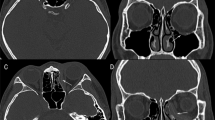Abstract
Purpose
To evaluate the transconjunctival preseptal approach for time required for exposure, adequacy of exposure, intraoperative and postoperative complications.
Materials and Methods
Materials for this study involved 15 cases of maxillofacial injuries with orbital floor and infraorbital rim fracture.
Results
The average exposure time taken for placement of incision till the exposure of the fracture was 21 min. Exposure obtained for fracture site was adequate in all cases, for the reduction of orbital floor and internal fixation of infraorbital rim. No cases had intraoperative and postoperative complications. In all cases postoperative esthetic outcome was satisfactory.
Conclusion
The transconjunctival preseptal approach is most effective surgical access to infraorbital rim and orbital floor and even to medial orbital wall. This approach is surgically similar in providing exposure and access, but aesthetically superior to other approaches and has minimal complications. There are no disadvantages to transconjunctival preseptal approach, if performed meticulously with sound knowledge of anatomy of periorbital tissues.






Similar content being viewed by others
References
Wesley RE (1998) Transconjunctival approaches to the lower lid and orbit. J Oral Maxillofac Surg 56:66–69
Eppley BL, Custer PL, Sadove AM (1990) Cutaneous approaches to the orbital skeleton and periorbital structures. J Oral Maxillofac Surg 48:842–854
Lorenz HP, Longaker MT, Kawamoto HK (1999) Primary and secondary orbit surgery: the transconjunctival approach. Plast Reconstr Surg 103:1124–1128
Wray RC, Holtmann B, Ribaudo JM, Keiter J, Weeks PM (1977) A comparison of conjunctival and subciliary incisions for orbital fractures. Br J Plast Surg 30:142–145
Appling WD, Patrinely JR, Salzer TA (1993) Transconjunctival approach vs subciliary skin-muscle flap approach for orbital fracture repair. Arch Otolaryngol Head Neck Surg 119:1000–1007
Baumann A, Ewers R (2001) Use of the preseptal transconjunctival approach in orbit reconstruction surgery. J Oral Maxillofac Surg 59:287–291
Manganello-Souza LC, De Freitas RR (1997) Transconjunctival approach to zygomatic and orbital floor fractures. Int J Oral Maxillofac Surg 26:31–34
Zarem HA, Resnick JI (1991) Expanded applications for transconjunctival lower lid blepharoplasty. Plast Reconstr Surg 88:215–220
Holtmann B, Wray RC, Little AG (1981) A randomized comparison of four incisions for orbital fractures. Plast Reconstr Surg 67:731–735
Hadeed H, Ziccardi VB, Sotereanos GC, Patterson GT (1992) Lateral canthotomy transconjunctival approach to the orbit. Oral Surg Oral Med Oral Pathol 73:526–530
Ilankovan V (1991) Transconjunctival approach to the infraorbital region: a cadaveric and clinical study. Br J Oral Maxillofac Surg 29:169–173
Waite PD, Carr DD (1991) The transconjunctival approach for treating orbital trauma. J Oral Maxillofac Surg 49:499–503
Manson PN, Ruas E, Iliff N, Yaremchuk M (1987) Single eyelid incision for exposure of the zygomatic bone and orbital reconstruction. Plast Reconstr Surg 79:120–126
Wilson S, Ellis E III (2006) Surgical approaches to the infraorbital rim and orbital floor: The case for the subtarsal approach. J Oral Maxillofac Surg 64:104–107
Baqain ZH, Malkawi Z, Hadidi A, Rajab LD (2008) Subtarsal approach for orbital floor reapair: a long-term follow-up of 12 cases in a Jordanian teaching hospital. J Oral Maxillofac Surg 66:45–50
Author information
Authors and Affiliations
Corresponding author
Rights and permissions
About this article
Cite this article
Santosh, B.S., Giraddi, G. Transconjunctival Preseptal Approach for Orbital Floor and Infraorbital Rim Fracture. J. Maxillofac. Oral Surg. 10, 301–305 (2011). https://doi.org/10.1007/s12663-011-0246-5
Received:
Accepted:
Published:
Issue Date:
DOI: https://doi.org/10.1007/s12663-011-0246-5




